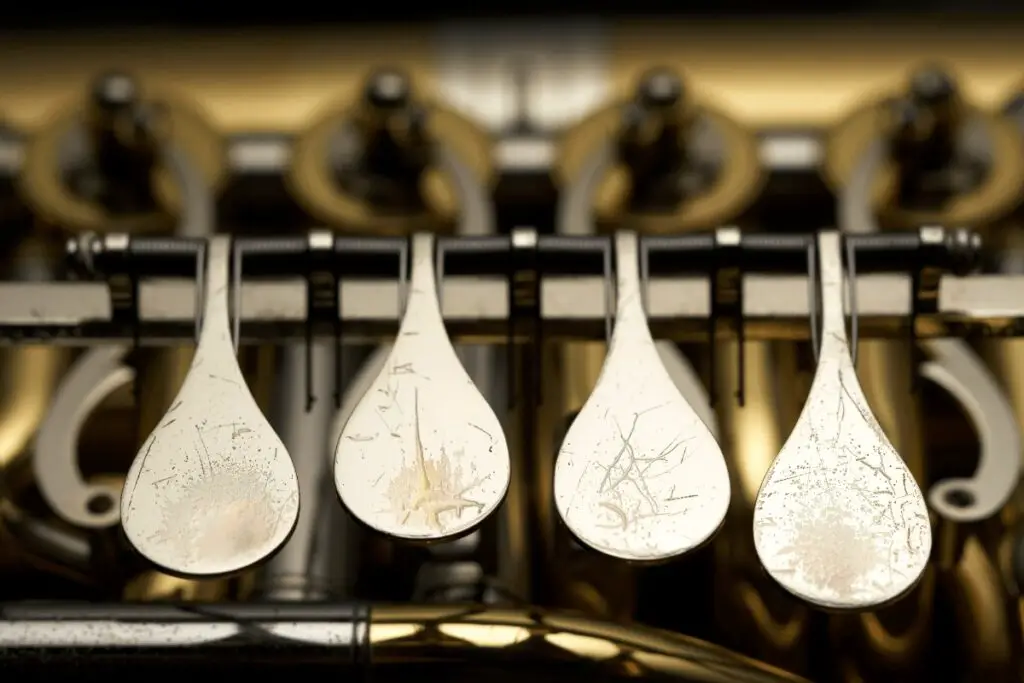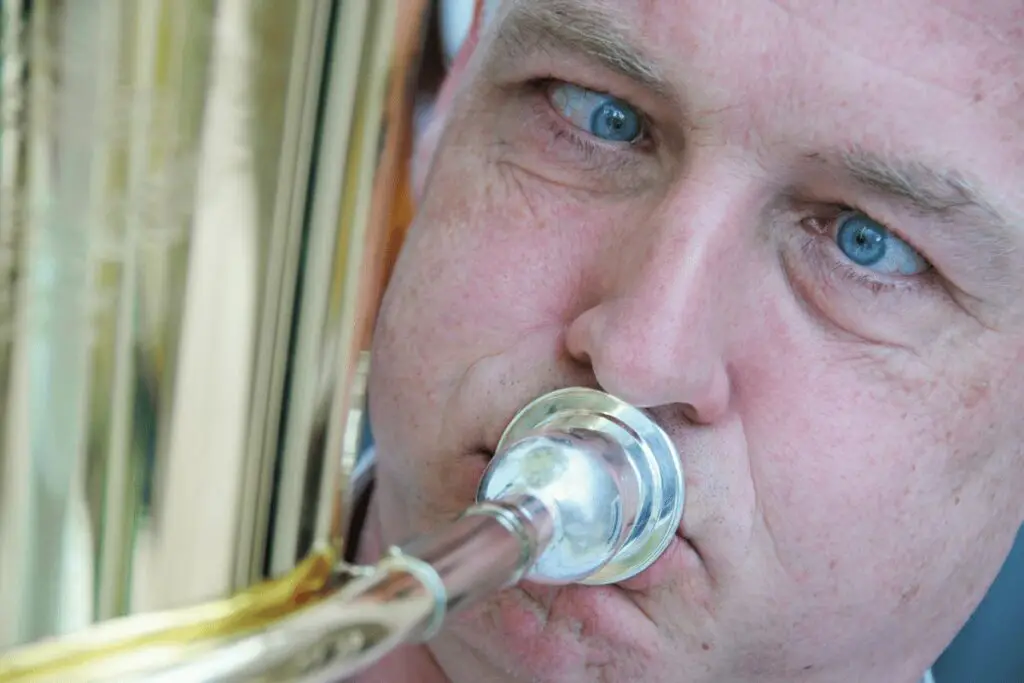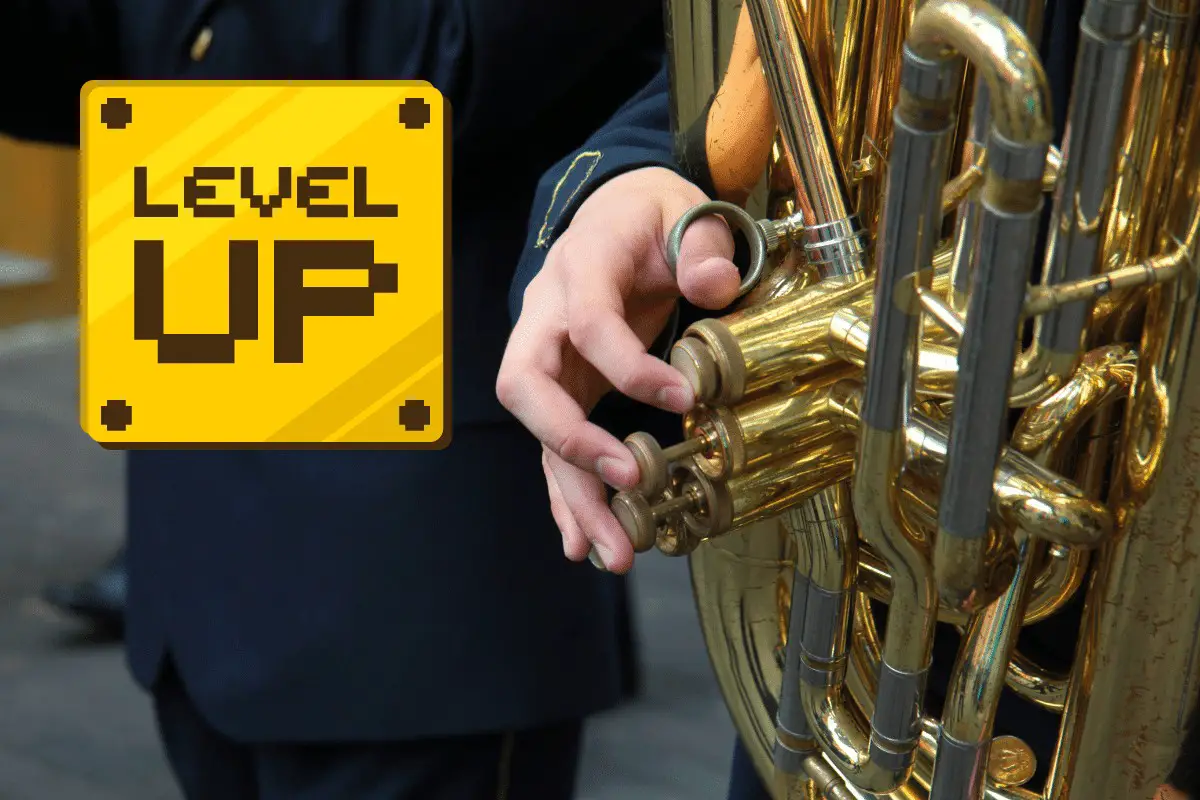The tuba is my favorite brass instrument.
Its low sound and powerful tone can support a band and carry a group.
But it’s pretty tough for many people, especially when they are new to the instrument.
With this in mind, I decided to pull on my 20-year experience and training playing this instrument to share these 15 tuba tips to help you, your students or your kids play the big instrument even better.
Let’s get playing!
Hey! If you like tuba stuff, check out my Instagram!
Table of Contents
Don’t Neglect Long Tones And Lip Slurs

As soon as I get ready to play, the first thing I do is start with some long tones.
I’ll play on the 5th above my fundamental (F for BBb tubas and G for CC tubas) and then work down the major scale with half notes or whole notes.
For BBb tubas, this would look like F-Eb-D-C-Bb.
Then, I go an octave above the fundamental and play down the whole major scale.
After this, I do some lip slurs from the open notes on the upper octave, down to the 5th, and then the fundamental.
I then do the same pattern down a half-step each time.
For BBb tubas, this looks something like this:
Bb-F-Bb. A-E-A. Ab-Eb-Ab. G-D-G. Gb-Db-Gb. F-C-F.
Doing these things first loosens your lips up like an athlete would do.
It also helps the player get better at hitting those different partials.
As you get better, start higher with your long tones and add more advanced lip slurs.
Tuba players do best when starting in their middle range, which is why I start long tones working down first.
Too many people force the tuba to try and start on their lowest note.
For new players, this is quite hard and can be discouraging.
These are also the steps I lead all my students through.
Do this every time you play, and you’ll notice you have a stronger sound and an easier time playing all sorts of notes.
Practice Your Breathing
Breath is power for any wid instrument, but this is especially true for the large bore and tubes of the tuba.
One of the first things any tuba teacher will do when they sit down with a new student is to practice breathing.
The more breath control and lung capacity you have, the more sound you’ll be able to produce.
While you don’t have to practice your breathing every day, you may want to do it regularly for a while (3x per week) until you feel a difference.
Then cut it back to once per week or twice per month to make sure you’ve still got it.
Here’s a quick breathing exercise:
- Sit without your tuba and take in as deep and silent a breath as possible.
- Keep your mouth wide open to make the fastest air intake possible.
- Don’t hold the air, but let it exit as soon as you feel full.
- As you exhale, make a circle with your lips or embouchure as if you were saying “Too.”
- Do this 4-5 times total. (Take a break. You may feel dizzy.)
- Now, hold your mouthpiece and do the same exercise breathing through your mouthpiece.
- On your inhale, open your mouth wider than the mouthpiece. On the exhale, put the air through the mouthpiece.
- Do this 4-5 times total. (Don’t forget that one or two-minute break.)
- Now, do the same exercise, but buzz on the exhale. It may help to cover the end of the mouthpiece slightly with your pinky to provide some backpressure.
- Get your tuba and put the mouthpiece on.
- Do the exercise breathing with your tuba (not playing).
- Then, do the exercise playing the 5th above your fundamental (F for BBb tubas and G for CC tubas).
- Don’t forget those breaks!
Check Your Posture
Posture is critical in avoiding injury and maximizing your breath potential.
Keeping a good posture with a tuba is challenging at times, depending on how the size and shape of the horn fit you.
Make sure you’re sitting with your back just off the chair.
Keep your feet flat.
Your hips, spine, neck, and head should all be evenly balanced and in line.
Bring the tuba to your good posture.
Don’t collapse or twist your body to fit the brass instrument.
It’s often a matter of exploration.
We often use either a tuba stand or shelving liner (the sticky kind to keep the horn from sliding off your leg).
Buzz To Train Your Lips And Ears
Any brass player or tuba player worth their salt will encourage you to buzz on your mouthpiece.
It trains your lips by making them more flexible.
It also trains your ears as you need to adjust your buzz to match the pitch you’re aiming pitch.
This will dramatically help your tuning or intonation.
Do the same exercise we did with our long tones and lip slurs, but just on your mouthpiece.
Use a recording if you need to help you stay on pitch.
Extend Your Low Range By Playing Down Chromatically
Tuba players are expected to just pop out low notes all the time.
It’s part of our role in any ensemble.
But our playing low notes is kind of like how a trumpet player plays high notes.
We have to work at it.
One of the best ways to improve your low note playing is to work your way down.
Start on the fundamental of your instrument.
Playing half notes, play your fundamental, go down one half step, and then return.
Take a breath and then start on the second note you just played, go down a half step, and return.
Repeat, working your way down in half steps.
A BBb tuba would play the following notes.
- Bb-A-Bb
- A-Ab-A
- Ab-G-Ab
- G-Gb/F#-G
- Gb-F-Gb
- F-E-F*
If you have a three-valve tuba, this is as far as you’ll go.
Check out the three-valve vs. four-valve tuba in our comparison here.
Listen, Listen, Listen

I’ve long said it, but in order to have a good sound, you need to have a good sound concept.
You must have an idea in your mind of what a good tuba sounds like.
With this in mind, you’ll start to adjust your playing to get closer to your ideal sound.
How do you build this sound concept?
You listen! And listen some more!
Listen to great tuba players across a variety of styles and ensembles to get the right idea for your specific sound.
Here are some players to check out:
- Oystein Baadsvik
- Roger Bobo
- Chuck Dallenbach (Canadian Brass)
- Carol Jantsch
- Alan Baer
- Arnold Jacobs
- Velvet Brown
- Rex Martin
Test Out Different Mouthpieces
Tuba mouthpieces are a personal thing.
It takes some experimenting to find the right one for you, but there are general suggestions that’ll serve most people just fine.
The first one is: don’t use the mouthpiece that just comes with a tuba.
Most of the time, it’s OK but only just.
For a beginner tuba player, they may need a smaller cup to help them create sound easier via the backpressure.
Advanced players and professional players will want to experiment with bigger cups and sharper angles on their mouthpieces to find the right fit.
My wife prefers a round edge to hers, but I like the sharp edge on mine, for example.
It’s a personal thing.
In general, the Conn Helleburg mouthpiece and Perantucci PT36 mouthpiece will do the job for most players.
(Mine is a more expensive custom mouthpiece modeled on the Conn Helleburg if you were curious.)
Practice Consistently
Consistent practice is key to anyone getting better on any instrument, but it’s harder to do on the tuba when most students don’t have one at home.
Even if you can’t practice every day, try to work it out, so you get some work in 5 times per week (3 times minimum).
For those without their own (which are most people), consider one of the following options:
- Borrow one from your school (even if it’s just a sousaphone).
- Stay after school or get there early for a half hour.
Play Solos Or Etudes More
I’ll be the first to admit that tuba music for band and orchestra is often mind-numbingly easy.
If this is all you play, you’ll never really get any better.
Pick up some solos or etude books and challenge yourself by playing from here.
It’ll build your playing all around.
My favorite book of etudes is the Bordogni book of Etudes for tuba.
Record Yourself
Many a tuba player at the higher level of play will record themselves playing through something and then listen and watch it back.
Doing so gives you a more honest idea of your ability and sound, and it’ll make it much easier to pick up small habits you wouldn’t otherwise see unless you were able to look at it from the outside.
Don’t Neglect Your Tonguing And Agility
Just because tubas don’t normally play fast music and quick notes doesn’t mean we won’t have to at some point.
If you never practice it, you won’t be able to play them when it shows up.
Spend time playing faster notes and exercises too.
Set your metronome at a slow tempo first, and then work your way up 10 BPM every time.
See how fast you can play an exercise or scale.
Make it a self-competition and track your speed to push yourself.
This musical instrument doesn’t have to play clunky and bulky all of the time.
Check out our list of the best F tubas for better high and quick playing.
Realize Your Embouchure Changes Based On Your Range

Lip placement makes a difference when you play.
Most of your range should use a 50-50 split of your upper and lower lips.
For your upper range, you almost need to roll your lower lip in a little and let the upper lip do more work.
For the low range, consider letting your lower lip do more (60-40 or 70-30).
Some people find it easier to make a pouty lip for their low notes.
Learn more tips in our article on how low tubas can play.
Make Sure You Have A Good Tuba
You’re only as good as your tuba, so make sure it’s a good one.
The average player should have a BBb tuba (often just called a Bb tuba), and they get and learn how to play with 4 valves.
As cool as bell-front tubas look, tubas with the bell going up are the better option.
Also, don’t buy a sousaphone (marching tuba).
Technically, they’re similar instruments, but real tubas always sound better.
Play In Different Types Of Groups
Don’t get stuck playing in only one group.
If you only have time for one band, that’s fine, but the more varied types you play in, the better you’ll be.
Every group I play in has its own challenges, and they each teach me a different lesson.
But the band by itself doesn’t usually offer many challenges in each piece of music.
Here’s a quick example of what I mean:
- Bands teach me to listen and blend in with different sections.
- Brass bands build my tuning.
- Orchestras teach me to count and play with confidence.
- Brass quintets build my technique and skill.
- German band/Polka band is just plain fun (and develops sight-reading and sheet music reading skills).
- Marching bands build memorization.
Take Private Lessons
Of course, there is no better way to improve your tuba playing than by taking private lessons.
Doing so from an expert will get you instant improvement due to the specific feedback you get from the teacher.
It costs more, yes, but it’s worth it!


